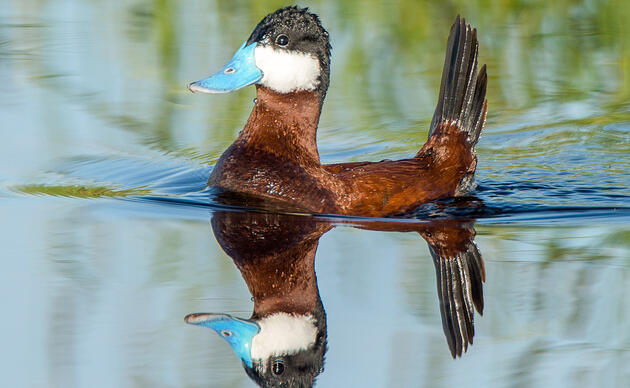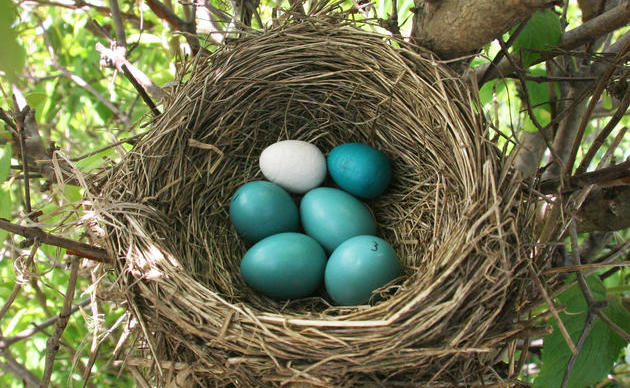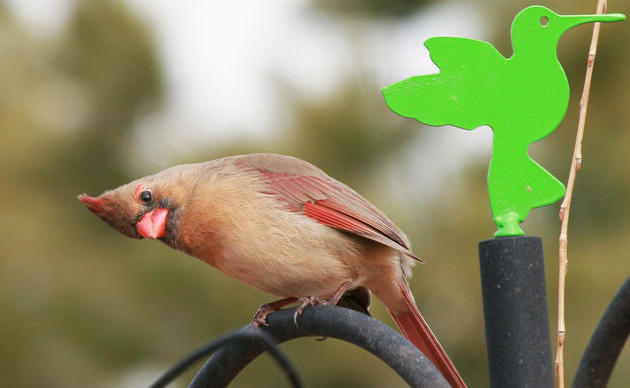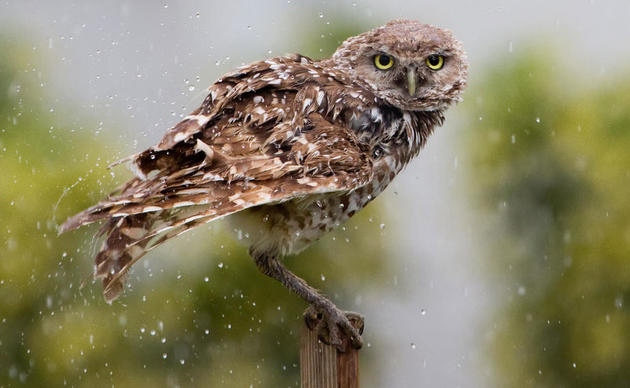Survival By Degrees
On October 11th, 2019, a new study - Survival by Degrees- 289 Bird Species on the Brink - was released from National Audubon Society scientists that builds on Audubon’s 2014 Birds and Climate Change Report that revealed climate change is the number one threat to birds. The Audubon’s scientists continued to closely analyze this relationship using the latest climate science research methods and modeling, while significantly expanding their pool of data sources and bird records to capture a deeper, more extensive analysis of the effects of climate change on North American bird species. The latest report shows that North American birds are more vulnerable than ever from rising temperatures and climate-related events like sea level rise, droughts, fires, and extreme weather. Over time, a complex suite of changes in climate and vegetation will inevitably affect Pennsylvania's bird communities. The good news is that our science also shows that if we take action now we can improve the chances for the majority of species at risk from climate change. Our birds are telling us that it’s time to act now.
How To Help
As an indicator species, birds are telling us that there is still time to get this right if we take action now and demand action from our elected officials at every level of government. We must reduce greenhouse gas emissions at an urgent speed and on a wide scale from every sector of the economy—electricity generation, agriculture, transportation, commercial and residential buildings, and industrial processes.
There are five actions we must take:
- Reduce your use of energy at home and ask your elected officials to support energy-saving policies that reduce the overall demand for electricity.
- Ask your elected officials to expand consumer-driven clean energy development that grows jobs in your community.
- Reduce the amount of carbon released into the atmosphere. In order to drive down carbon emissions, we will need economy-wide solutions that address every sector of the economy—like a fee on carbon. Another option is to address carbon emissions one sector at a time, like setting a clean-energy standard for electricity generation.
- Advocate for natural solutions, such as increasing marshlands along coasts and rivers to absorb soaking rains from stronger hurricanes, and use more native plant species to help adapt our communities and landscapes to climate change.
- Ask elected leaders to be climate and conservation champions: - Tell your elected officials that climate and conservation are election issues for you. In Pennsylvania we have the unique opportunity to effect change by asking our legislators to pass state House Bill 531 in 2020 which would provide for access to Community Solar projects across the commonwealth.
Hope Equals A Bird-Friendly Forester
We were seated like undergraduate freshman atop stools at black lab benches in Penn State’s Forest Resources Building. Our “mock forester training” was coming to a close and our group’s energy was waning. Abruptly, Luke piped up. “Have you ever thought about the lifetime legacy of a forester?” The remaining seven of us looked at each other. “Of course we have,” someone said. This was a room full of forestry professionals who thought deeply about forest conservation. “No,” Luke said. “I mean have you really thought about, like done the math?” “Think about it,” he continued. “If a forester has a 35-year career and writes management plans for 500 acres per year, that means he or she has conservatively impacted 17,500 acres in their lifetime.” “That impact can either be good or bad for sustainable forestry.” I was struck by the size of the number and quickly started extending the notion of “acreage legacy” to the hundreds of foresters who work in Pennsylvania’s forests.
Audubon PA, along with other partners, has created a bird-friendly forester training program that was piloted at Penn State’s Forest Resources Building this Fall. A mock-training was conducted to seek input from forestry professionals about the content, format, and tone of this new endeavor. This program, which is part of our Healthy Forest Initiative, is targeted toward consulting and agency foresters. The goal is to teach participants about the habitat needs of forest-dependent birds and how to implement sustainable practices to meet those needs, while still hitting commercial, recreation, and aesthetic objectives.
The training is two days, including a full day of classroom learning, with presentations by Audubon staff and many of our partners, such as Penn State Extension, Ruffed Grouse Society, Department of Conservation and Natural Resources, Pennsylvania Game Commission, and the Natural Resources Conservation Service. On the second day, participants visit field demonstrations sites to see how bird-friendly forestry looks in practice and engage in various management scenarios.
Our nascent program has already trained nearly 50 foresters. Reactions to our program have been very enthusiastic, with foresters describing how much they enjoyed learning about birds and how to put that new knowledge to work in their forest management plans. If we follow Luke’s math and assume these foresters are half way through their careers, that’s nearly 9,000 acres potentially improved for birds and overall forest health. It’s easy to see how those numbers add up over time. Clearly, science-based training could help move the needle on statewide forest health.
All this is to say, that a forester’s legacy might just represent hope to forest-dwelling birds whose populations have declined by 17% or about 170 million birds since 1970 (Roseburg, et al. 2019). Forest health begins with science-based management and Audubon PA is leading the charge on behalf of birds and other wildlife.
Delaware River Habitat Project Kicks Off
Audubon Pennsylvania is part of the Delaware River Watershed Initiative, a network of 65 organizations working to improve water quality throughout the Delaware River Watershed, funded by the William Penn Foundation.
Following targeted watershed assessments, the DRWI used scientific data and modeling to identify eight focal locations within the watershed. Audubon works within the Schuylkill Highlands location, which covers parts of twenty-one municipalities in northern Chester County and southern Berks County, providing strategies to improve habitat and clean water.
This fall, we started working to improve bird habitat for Louisiana Waterthrush and other species through homeowner engagement and native planting. Our first habitat project was completed within the Schuylkill Highlands, and it was a great success! Volunteers and staff planted shrubs along a tributary of French Creek at the Potter’s Pond neighborhood in Schuylkill Township, Chester County, in partnership with Yellow Springs Farm.
The neighborhood was brought to our attention by our partners at French and Pickering Creeks Conservation Trust due to stormwater and invasive plant issues. Other partners in the Schuylkill Highlands location are Berks Nature, Green Valleys Watershed Association, Natural Lands, Partnership for the Delaware Estuary and Stroud Water Research Center.
Audubon plans to provide planting opportunities to individual Schuylkill Highlands residents in the coming year. If you live in northern Chester County or southern Berks County and are interested in enhancing your streamside property with native plants, Audubon Pennsylvania wants to hear from you! You’ll have access to the Audubon team along with our professional design partners, free native plants to start your bird-friendly habitat, a resource kit for additional planting ideas and the opportunity to take part in bird monitoring. For more information, please email Jeanne Ortiz or visit our webpage here.
Connecting Neighbors to Nature
At Audubon, we know the innumerable benefits of utilizing native plants in the landscape and we’re working hard to spread that message, encourage advocacy, and cultivate grassroots support for increasing their use in community green spaces. Community Blooms, an Audubon Plants for Birds project in the City of York, rallied staff, volunteers, neighbors, and partners to add beauty to the neighborhood, improve habitat for birds, and encourage the use of native plants by showcasing them in high visibility, highly walkable community learning gardens.
The series of six Community Blooms gardens, all located within a six-block radius of Kiwanis Lake and Willis Run, feature a range of native plants, different environmental themes, educational signage, and volunteer opportunities. The gardens also highlight the connections between enhancing our green spaces, supporting wildlife, managing stormwater runoff and reducing pollution. Each garden was situated within the footprint of the Important Bird Area of Kiwanis Lake where Pennsylvania endangered Great Egrets and Black-crowned Night Herons nest annually. Kiwanis Lake is one of only two nesting sites in all of Pennsylvania for the Great Egrets.
Over 300 native plants, shrubs, and trees replaced over 3,000 square feet of mowed lawn and non-native shrubs in six community learning gardens. The Community Blooms partnership brought together the City of York, York City Schools, the Devers Area Neighborhood Association, the 2019 class of Master Watershed Stewards at the Penn State Extension office of York County, York College of Pennsylvania, and the York County Master Gardeners. The projects were made possible in part thanks to generous support from the Codorus Watershed Fund of York County Community Foundation and the Chesapeake Bay Foundation.
Chapter Gathering
On October 19, 2019, over two dozen leaders form 15 Audubon chapters across the state came together at the Benjamin Olewine III Nature Center at Wildwood Park in the heart of Harrisburg. It was a perfect gathering place for our 2019 chapter gathering, complete with plenty of birds fluttering by the windows to remind us of the important work we have ahead of us.
In October, Audubon released a new report on climate change, Survival by Degrees: 389 Birds Species on the Brink. Understanding that this is a defining issue of our time, the foundation for the day centered around the report and the multitude of ways the state office and chapters can engage people at a variety of levels to advocate for birds and the landscapes they both need for survival.
Topics for the day included the Community Solar initiative in Pennsylvania; engaging municipalities through native plant proclamations, resolutions, and ordinances; a deep dive into the Survival by Degrees report and associated toolkit of resources; and broadening our reach into communities through high visibility community gardens, diverse partnerships, and chapter collaborations.
The gathering inspired a renewed sense of commitment and dedication to the mission of Audubon and to each other as we all work together toward shared goals. As a result of the gathering, Audubon Pennsylvania has committed to consistent, structured communications; tailored trainings and workshops; and strengthened connections across all parts of the Audubon network. We are excited to see what the coming year of collaboration will bring to the Audubon network and the positive impacts our shared work will have on the birds we love.
Audubon’s Delaware River Watershed Program Director Tapped to Shape Regional Watershed Plans and Climate Resiliency
With appointments to two regional commissions, Audubon aims to influence conservation and policy to protect the birds and people of the watershed.





